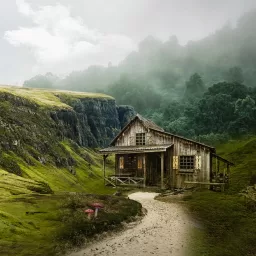Script Analysis: WHERE THE WILD THINGS ARE
SPOILER ALERT: If you haven’t yet seen “Where The Wild Things Are,” you may want to check it out before you read this article. Let’s set aside the question right now of whether or not Where The Wild Things Are is a good movie. Let’s set aside the question of whether you liked it or not (or were a little bit embarrassed for liking it as much as you did).
And if you feel like you wasted your twelve bucks on a movie in which essentially nothing happens, let’s set that aside too. Love it or hate it, Wild Things is a movie worth studying, because of the bold and unique ways it is structured to reflect its authors’ premise, both in its most wonderful, and its most problematic elements.
PREMISE? WHAT PREMISE?
Wild things is governed by a simple idea– or at least a strong suggestion– that we are seeing the whole world through the perspective of a young boy– as he works out his rage over his isolated life (and more importantly, his parents divorce) by playing with a bunch of stuffed animals in his room.
The writer-director team of Jonze and Eggers make a very strong (and very risky) decision that nothing in the world of the Wild Things is going to exist outside what a boy Max’s age could reasonably imagine. This is embodied in every element of the film:
In the dialogue and actions of the Wild Things (who reason and dream and play and rage and even accept the impossible just like children). In a plot limited to events that a moderately intelligent child could be expected to dream up–more interested in reflecting the way children play (with exaggerated simplicity, loose ends, and non-linear and non-sensical elements) than it is with telling a linear narrative story.
In the production design– which looks a lot more like what a child like Max might think was “cool and magical” than what we’ve come to expect from the grown up Hollywood minds that bring us movies like Harry Potter or Pan’s Labyrinth. In Where the Wild Things Are, boats to magic lands show up out of nowhere, Wild Things instantly accept little boys as Kings, and torn off arms drip sand and not blood. We are in a little boys world of stuffed animals, and if things seem cheesy, overly simple, or just plain goofy, it’s because they’re supposed to.
Because of these choices, the experience of Where The Wild Things Are completely violates almost everything we’ve come to expect in a Hollywood movie. We come expecting magic and spectacle, and are given only the simplest special effects. We come expecting a smooth ride, that’s safe for kids, and fun for adults, and instead are taken on a chaotic journey that floats along the impetuous currents of Max’s joy and rage. We come expecting a “well-made” film, and instead experience the inner world of a child at play.
STRUCTURE? WHAT STRUCTURE?
Most Hollywood movies are built around simple structural rules. If a character shows up at the beginning of the movie pretending to be King, the movie isn’t over until he’s learned what it is to be a real King. If a character shows up at the beginning of the movie in a land where a bunch of otherwise lovely creatures are filled with rage and misery, the movie isn’t over until he’s healed their pain (and his own) and found a way to bring them peace.
As you probably noticed, Wild Things doesn’t play by these rules. Max doesn’t heal the Wild Things. Max doesn’t learn how to be a good King. Max doesn’t even “finish” the story. Rather, he leaves abruptly (if reluctantly) abdicating his crown like a child called inside for dinner.
For the most part, nothing happens in Wild Things. And yet, from a character perspective, so much happens. The difference is that unlike almost every other Hollywood film of its genre, Wild Things builds its structure not linearly and logically, but emotionally and symbolically, through the use of archetypes.
WHAT THE HECK IS AN ARCHETYPE?
Archetypes are an idea derived from the work of psychologist Carl Jung, and later seized upon by Joseph Campbell and a slew of his disciples as they sought to better understand story. You could spend years studying the different ways different critics, professors, and authors of screenwriting books have described and categorized archetypes.
Fortunately, you don’t have to.
Your job as a writer is not to categorize or memorize archetypes, but to understand them. And understanding them begins with this simple concept:
An archetype is a character who embodies some repressed element of your main character’s psyche, and exists structurally in your movie to force your character to deal with that repressed element. All movies have archetypes. Big Hollywood movies. Tiny independent movies. Broad Comedies. Serious Dramas.
Even big dumb action movies. They all have archetypes. They have to. Otherwise, your main character would never have to deal with the repressed elements in his or her psyche, and wouldn’t have to go through the story. The difference is that within Wild Things, instead of existing in a traditional linear plot, these archetypes exist within an emotional and symbolic one.
THE NORMAL WORLD
One of the truly remarkable things about Where The Wild Things Are is how quickly screenwriters Jonze & Eggers establish all of the real world emotional and symbolic elements that will comprise the structure of Max’s mythical journey. His isolation and loneliness. His emotional and physical pain. His feelings of betrayal by his sister and his mother. HIs feelings of being left behind as his mother and sister build relationships with new people that he doesn’t like or understand. His shame at being out of control. And most importantly, his violent and destructive reactions to those feelings.
These emotional elements have symbolic counterparts: The Snowball Fight That Ends In Tears. The Destroyed Fort. The Heart He Made For His Sister (which he destroys when he trashes her room). And the moment in which he Bites His Mother after seeing her with her new boyfriend.
THE EMOTIONAL/SYMBOLIC WORLD OF THE WILD THINGS
On a metaphorical level, Max’s journey in the world of the Wild Things is quite simply an attempt of a child’s mind to make sense of his own destructive rage. Each emotional and symbolic element of the normal world has its Wild Things World equivalent, creating a system of metaphorical mirrors through which Max ultimately can see himself and his world more clearly (as he self soothes his way through the guilt and trauma).
The Wild Things bite, just as Max bit his mother. The Wild Things destroy their homes, Just as Max destroyed his sister’s room. Max attempts connect with the Wild Things by building a fort and throwing dirt clods, just as he once built a snow fort and threw snow balls at his sister’s friends. The connections are simple, giving the movie the clarity and through line it needs to take the audience along for the journey. But also complex, honoring the complexity of Max’s pyschology, as he navigates the complexities of his parents divorce and his feelings about it, by navigating his relationships with one archetypal Wild Thing after another.
CAROL: The loving, but violent father, with whom Max’s mother no longer wants to live despite Max’s love for him, and whose behavior Max is emulating in his own.
KW: The perfect mother figure, who “inexplicably” no longer wants to live with Carol, and is instead enamored with “boyfriends” Bob and Terry, the owls that neither Max nor KW can understand.
JUDITH: The embodiment of his jealousy and discontentment– who feels like it’s Max’s job to make her feel better, just as Max wants his mother to do for him.
Even Max himself is an archetype: the quintessential Jungian “Hero”. The developing Ego that wishes to be King of his own world.
Over the course of the story, by interacting with his archetypes and attempting to do for them what he wishes to do for himself, Max develops empathy and understanding that prepares him to return to his new world. He is forced to confront who his father really is, who his mother really is, and even who he really is. He is forced to confront the consequences of his choices, and the terrifying idea that he may not be in control, that he may not be King, that he may, in fact, just be a “boy, pretending to be a wolf, pretending to be a king” and that in fact Kings may not exist at all.
It ends with the gift of a heart that Max has made. Not coincidentally, it looks a lot like the one he once made for his sister, and destroyed at the beginning of the movie. Linearly, not a darn thing happens. But metaphorically, emotionally, and symbolically, Max undergoes a profound change. He must, otherwise he wouldn’t need to go through the story.
THE WRITER’S JOURNEY
On an archetypal level, Max’s journey echoes the journey of every writer. We must reduce ourselves to children, allow ourselves to play, breathe life into our own archetypes through the words and actions of our characters, create metaphorical and symbolic equivalents for the confusing and contradictory events of our own lives, and ultimately create a structure that forces us to unearth our own repressed emotions, and takes us, and our main characters, on a journey that changes us both forever.
Though your own work may not be as structurally radical as that of Where The Wild Things Are, if a movie in which so little happens can create such a profound journey for its main character, imagine what exploring these emotional, archetypal, and symbolic elements could do for your own work.
AUTOPOST by BEDEWY VISIT GAHZLY







